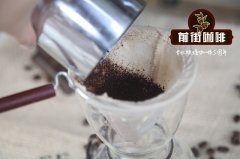How to drink Yemeni mocha coffee? How to drink mocha in fancy style? What are the flavor characteristics of mocha?
How to drink Yemeni mocha coffee? How do you drink mocha coffee? What is the flavor of mocha coffee beans?

It is also located on the Arabian Peninsula of the Asian continent, but it is very close to the African continent just across the Red Sea and the Gulf of Aden Gulf of Aden, but other Arab countries do not produce coffee, so the world classifies Yemeni coffee as a member of North African coffee. So what is the Yemeni mocha? Mocha is the export port of Yemeni coffee, because it is difficult to name all the tiny sub-producing areas in the history of coffee trade, even though the coffee produced by these small producing areas is very good, so they have to use the name of the place of export. the sun beans nearby, including East Africa, were exported from the port of Mocha to all parts of the world in the early days, and now the port of Mocha has long been silted up and disappeared. Many Ethiopian sun beans also name themselves mocha, such as Haramoka, which we know well. I think this is because its flavor has a little bit in common with Yemeni coffee.
Yemen is probably the first country in the world to use coffee as a cash crop. Legend has it that it was brought in by Muslim Sufi pilgrims from Ethiopia in the 6th century. Yemeni exporters never buy directly from the farm, but from the big market dealers in the middle. The coffee received by the local market passageway is with pods and is usually stored in a cool cellar. The special flavor of Yemeni coffee loved by the world may come from their ancient way of trade, and farmers have not been victimized by the way they trade through the market. The main reason is that the local planting land is limited, coupled with high latitudes and limited water resources, the output is very scarce, and the demand is very high, keeping the price high.
The most correct spelling of mocha should be Al-Mahka, which is the Arabic spelling, but in the end, what you see on the sack is the correct spelling of Mocca or Mocha, regardless of some naming and spelling trivia, Yemeni coffee is the most unique and expensive coffee in the world, the overall style is [wild] or [natural] and the complexity is extremely high, for some people it is spicy and pungent But in any case, you must try it sometime. You will find that you like this unique coffee very much. If you also fall in love with him deeply, it will be the beginning of a whole new coffee journey.
It is not easy for Yemeni coffee to grow and harvest. Most farmland also grow Qat katgrass, which is said to have a mild and refreshing effect. This plant will absorb water from the ground and destroy the underground aquifer. Planting coffee is different. I hope that some changes can be made to make farmers stop planting katgrass. Yemen Harasi Harari is a small producer of coffee. Coffee is grown on terraces and there is no data to verify the wild species. What's so special about this bean? If you expect him to be very miscellaneous and earthy, you may think it's great that Harasi Harari is different from Haimi, Saab, Supreme and other clean coffee, which is the same tone as Eshmael and Sonani, and the dirt is dirty with a fleshy flavor.
Farm characteristics
Farm farm name: Small producers small producing group
Name name: Mocha Harasi Mocha Haimi
Grade: naturally dried Arabica beans, no regulatory body, no grading system
Production area: Harazi District Harazi area
Country: Yemen Yemen
Certification: without certification, all coffee is grown organically in accordance with the ancient method, and pesticides containing chemicals are not used.
Coffee characteristics
Varieties: 10 special native mocha species are mainly Jaa'di,Taffahi and Dawairi.
Treatment: Method Traditional Sun Dried traditional sun drying of ripe cherry fruits in African (sun) elevated bed drying
Harvest time: the harvest period of major crops is from October to December, and the second harvest is in some producing areas in April.
Appearance: 15-16 mesh
Overall style attributes: strong earthy taste, thick taste, with the shadow of Yishi Mary
Comments: the baking degree measured by the cup for 60 seconds at the beginning of the first explosion
Aroma / flavor flavor: cloves, five-spice powder, chili, mango, strawberry, grapefruit tea, fruit wine, cherry, wood, earthy, dark chocolate
Acid quality: tartaric acid, mint, tropical fruit acid, cranberry acid, red gluconic acid
Complexity and other other: complex and changeable, fermented wine, grass bitter tea flavor, full of earth flavor, thick and heavy taste
Important Notice :
前街咖啡 FrontStreet Coffee has moved to new addredd:
FrontStreet Coffee Address: 315,Donghua East Road,GuangZhou
Tel:020 38364473
- Prev

Taste treatment method for flavor description of Yega Ficochel native G1 boutique coffee beans
Yega Xuefei G1 Kochel washing flavor characteristics? How to handle it? Introduction to the water washing method of local native species producers, local cooperative smallholder treatment, the highest grade of ECX, grade G1, 1900-2000 meters above sea level, located in Sidama province.
- Next

Varieties and types of mocha coffee beans in Yemen? Flavor characteristics and taste? Planting history?
Varieties and types of mocha coffee beans in Yemen? Flavor characteristics and taste? Planting history? Mocha Mocha Coffee refers to five types of mocha. The first export port of coffee-the Yemeni port of Moka (the vanished harbor) 2. Coffee brewed in a mocha pot. Italian latte with chocolate 4. The origin of coffee-mocha beans from Hara, Ethiopia, 5. The oldest hometown of coffee
Related
- Detailed explanation of Jadeite planting Land in Panamanian Jadeite Manor introduction to the grading system of Jadeite competitive bidding, Red bid, Green bid and Rose Summer
- Story of Coffee planting in Brenka region of Costa Rica Stonehenge Manor anaerobic heavy honey treatment of flavor mouth
- What's on the barrel of Blue Mountain Coffee beans?
- Can American coffee also pull flowers? How to use hot American style to pull out a good-looking pattern?
- Can you make a cold extract with coffee beans? What is the right proportion for cold-extracted coffee formula?
- Indonesian PWN Gold Mandrine Coffee Origin Features Flavor How to Chong? Mandolin coffee is American.
- A brief introduction to the flavor characteristics of Brazilian yellow bourbon coffee beans
- What is the effect of different water quality on the flavor of cold-extracted coffee? What kind of water is best for brewing coffee?
- Why do you think of Rose Summer whenever you mention Panamanian coffee?
- Introduction to the characteristics of authentic blue mountain coffee bean producing areas? What is the CIB Coffee Authority in Jamaica?

